Molti utenti di WordPress preferiscono lavorare sui propri siti web utilizzando un server locale sul proprio computer. In questo modo è possibile lavorare sul sito web in modo privato prima di rendere disponibili le modifiche on line.
Alla fine, dovrete spostarlo su un server live per renderlo accessibile ai visitatori online. Questa transizione è fondamentale per garantire il corretto funzionamento del sito web on line.
Abbiamo lavorato su molti siti web locali, quindi abbiamo dovuto imparare il modo più semplice per trasferire i contenuti a siti web in carne e ossa.
In questo articolo forniremo istruzioni passo passo su come spostare WordPress da un server locale a un sito live.
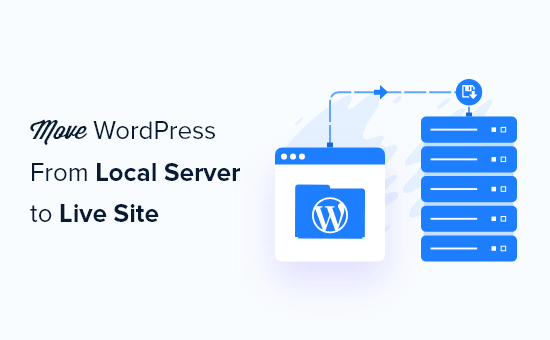
Perché spostare WordPress da un server locale a un sito live?
Creare il vostro blog WordPress su un server locale è un modo sicuro per testare le modifiche apportate al vostro sito web senza influenzare i visitatori.
Una volta perfezionato il sito web, il passo successivo consiste nel passare dal server locale a un sito live.
Vi mostriamo due modi per spostare il vostro sito da un server locale a un sito live.
Il primo metodo utilizza un plugin di migrazione di WordPress ed è consigliato ai principianti.
Nel secondo metodo, vi mostreremo come spostare manualmente WordPress da un server locale a un sito live.
Potete scegliere il metodo più adatto a voi:
Prima di migrare il sito WordPress
Per migrare WordPress da un server locale a un server live è necessario disporre di alcuni elementi.
Innanzitutto, supponiamo che abbiate un sito WordPress in esecuzione su un server locale (chiamato anche localhost) sul vostro computer e che abbiate pieno accesso ad esso.
Successivamente, è necessario disporre di un nome di dominio e di un hosting web.
Abbiamo sentito innumerevoli storie di principianti che hanno iniziato con fornitori di hosting web scadenti o gratuiti e se ne sono pentiti. Secondo la nostra esperienza, la scelta del giusto fornitore di hosting è fondamentale per il successo di qualsiasi sito web.
Per facilitare la vostra decisione, vi consigliamo di utilizzare Bluehost. Si tratta di una società di hosting WordPress ufficialmente raccomandata, che offre agli utenti di WPBeginner uno sconto esclusivo + dominio e SSL gratuiti.
In pratica, potete iniziare a lavorare con soli 1,99 dollari al mese.
Se volete un’ottima alternativa a Bluehost, potete dare un’occhiata a Hostinger. Offre anche uno sconto esclusivo agli utenti di WPBeginner con un nome di dominio gratuito.
Se potete permettervi di pagare un po’ di più, allora date un’occhiata a SiteGround. Hanno anche un’offerta speciale per i lettori di WPBeginner.
Se avete bisogno di aiuto per creare il vostro sito web, seguite la nostra guida passo passo su come creare un sito web.
Infine, è necessario disporre di un programma FTP e sapere come usare l’FTP per caricare il sito del server locale sul sito live.
Siete pronti? Iniziamo la migrazione del vostro sito WordPress.
Video tutorial
Se preferite le istruzioni scritte, continuate a leggere.
Metodo 1: Trasferire WordPress dal server locale al sito live utilizzando un plugin di migrazione (consigliato)
Questo metodo è più semplice e consigliato ai principianti. Utilizzeremo un plugin di migrazione di WordPress per spostare WordPress da localhost a un sito live.
Passo 1: Installare e configurare il plugin Duplicator
Per prima cosa, è necessario installare e attivare il plugin Duplicator sul sito locale. Per maggiori dettagli, consultate la nostra guida passo-passo su come installare un plugin di WordPress.
Suggerimento professionale: Esiste anche una versione pro di Duplicator che offre backup sicuri, archiviazione su cloud, ripristino semplice del sito e altro ancora.
Dopo l’attivazione, è necessario andare alla pagina Duplicator ” Backups e fare clic sul pulsante ‘Create New’.
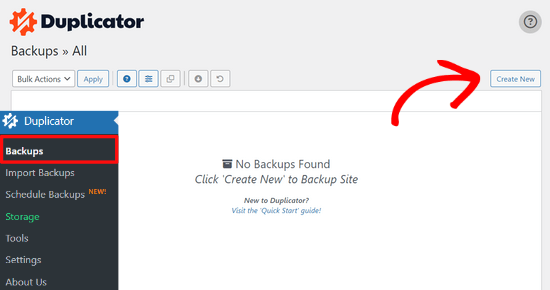
Si accede così a una schermata in cui è possibile assegnare un nome al backup.
Quindi, fare clic sul pulsante “Avanti”.

Duplicator eseguirà ora alcuni test per verificare che tutto sia in ordine.
Se tutti gli elementi sono contrassegnati da “Buono”, cliccate sul pulsante “Costruisci”.

Questo processo può richiedere alcuni minuti, a seconda delle dimensioni del sito web. È necessario lasciare aperta questa scheda fino al completamento.
Una volta terminato, verranno visualizzate le opzioni di download per i pacchetti “Installatore” e “Archivio”. È necessario fare clic sul pulsante “Scarica entrambi i file” per scaricare entrambi i file sul computer.

Il file “Archivio” è una copia completa del vostro sito WordPress. Include tutti i file principali di WordPress, nonché le immagini, i caricamenti, i temi, i plugin e un backup del database di WordPress.
Il file “Installer” è uno script che automatizza l’intero processo di migrazione scompattando il file di archivio contenente il vostro sito web.
Fase 2: Creare un database per il vostro sito web WordPress dal vivo
Prima di eseguire il programma di installazione o di caricare il sito web WordPress da localhost al vostro server di hosting, dovete creare un database MySQL per il vostro nuovo sito web live.
Se avete già creato un database MySQL, potete saltare questo passaggio.
Per creare un database, è necessario visitare la dashboard del cPanel del proprio account di hosting. Quindi, individuate la sezione “Database” e fate clic sull’icona “MySQL Database Wizard”.
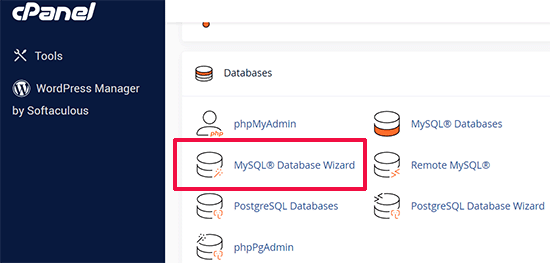
Nella schermata successiva, c’è un campo per creare un nuovo database.
È sufficiente indicare un nome per il database e fare clic sul pulsante “Crea database”.

cPanel creerà ora un nuovo database per voi.
A questo punto, è necessario inserire un nome utente e una password per il nuovo utente e fare clic sul pulsante “Crea utente”.
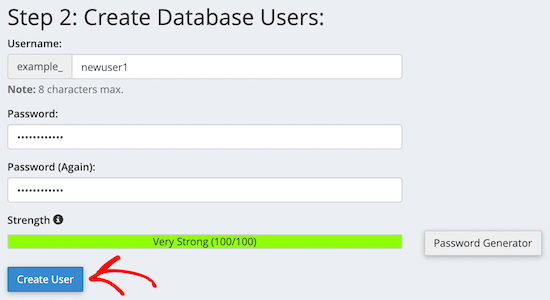
Successivamente, è necessario aggiungere l’utente appena creato al database.
Innanzitutto, fare clic sulla casella di controllo “Tutti i privilegi”.
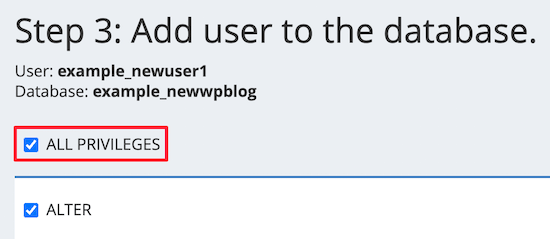
Quindi, scorrere verso il basso e fare clic sul pulsante “Applica modifiche” per salvare le modifiche.
Il database è ora pronto per essere utilizzato con il vostro sito WordPress. Assicuratevi di annotare il nome del database, il nome utente e la password. Queste informazioni vi serviranno nella fase successiva.
Fase 3: caricare i file dal server locale al sito web WordPress dal vivo
Ora è necessario caricare i file dell’archivio e del programma di installazione dal sito locale all’account di hosting.
Per prima cosa, collegatevi al vostro sito live utilizzando un client FTP. Una volta collegati, assicuratevi che la directory principale del vostro sito sia completamente vuota.
Normalmente, la directory principale è la cartella /home/public_html/.
Alcune società di hosting WordPress installano automaticamente WordPress al momento dell’iscrizione. Se sono presenti file di WordPress, è necessario eliminarli.
Successivamente, è possibile caricare i file archive.zip e installer.php da Duplicator nella cartella principale vuota.

Passo 4: esecuzione dello script di migrazione
Dopo aver caricato i file di migrazione, è necessario visitare il seguente URL nel browser:
http://example.com/installer.php
Non dimenticate di sostituire “example.com” con il vostro nome di dominio.
In questo modo si avvia la migrazione guidata di Duplicator.
Il programma di installazione eseguirà alcuni test e inizializzerà lo script.
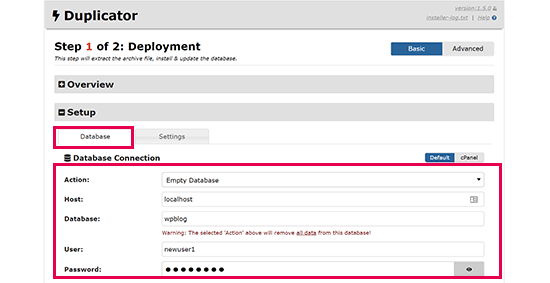
Nella sezione Setup, vi verrà chiesto di inserire l’host MySQL, il nome del database, il nome utente e la password.
L’host sarà probabilmente un host locale. Successivamente, si inseriranno i dettagli del database creato nel passo precedente.
Quindi, fare clic sul pulsante “Convalida” per verificare che i dati inseriti siano corretti.
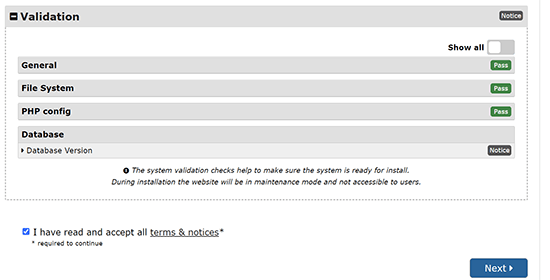
Dopodiché, fare clic sul pulsante “Avanti” per continuare.
Duplicator importerà ora il backup del database di WordPress dall’archivio al nuovo database.
Inoltre, aggiorna gli URL che puntano al sito locale e al nuovo sito live.
A questo punto è possibile fare clic sul pulsante “Admin Login” per accedere all’area di amministrazione di WordPress del sito live.

Una volta effettuato l’accesso al sito live, Duplicator pulirà automaticamente i file di installazione.
È tutto. Avete spostato con successo WordPress dal server locale al vostro sito live.
Metodo 2: Trasferire manualmente WordPress dal server locale al sito live
In questo metodo, vi mostreremo come spostare manualmente WordPress dal server locale al vostro sito live. Sarà utile se il primo metodo non funziona o se preferite farlo manualmente.
Passo 1: Esportare il database locale di WordPress
La prima cosa da fare è esportare il database locale di WordPress. Per farlo, utilizzeremo phpMyAdmin.
Se non lo conoscete, potete dare un’occhiata alla nostra guida alla gestione del database di WordPress con phpMyAdmin.
Basta andare su http://localhost/phpmyadmin/ e cliccare sul database di WordPress. Quindi, fare clic sul pulsante “Esporta” nella barra dei menu in alto.

Nell’opzione “Metodo di esportazione:” si può scegliere “Rapido” o “Personalizzato”. Personalizzato vi fornirà più opzioni per esportare il vostro database.
Tuttavia, si consiglia di scegliere “Rapido” e di fare clic sul pulsante “Vai” per scaricare il database.

Passo 2: caricare i file di WordPress sul sito live
Ora è necessario spostare tutti i file del sito web sul sito live.
Per iniziare, aprite il vostro client FTP e collegatevi al vostro account di hosting web.
Una volta collegati al sito live, assicuratevi di caricare i file nella directory giusta. Ad esempio, se si vuole che il sito sia ospitato su “yoursite.com”, si dovranno caricare tutti i file nella directory public_html.
Ora selezionate i file locali di WordPress e caricateli sul vostro server live.
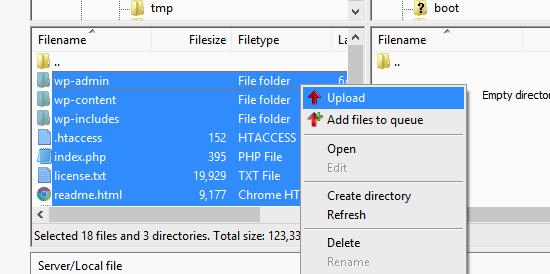
Passo 3: Creare un database MySQL sul sito live
Mentre il client FTP carica i file di WordPress, potete iniziare a importare il database sul server live.
La maggior parte dei fornitori di hosting WordPress offre cPanel per gestire il vostro account, quindi vi mostreremo come creare un database utilizzando cPanel.
Per prima cosa, è necessario accedere alla dashboard di cPanel e fare clic sull’icona “MySQL Database Wizard”, che si trova nella sezione “Database”.

Nella schermata successiva è possibile creare un nuovo database.
È necessario indicare un nome per il database, quindi fare clic su “Crea database”.

cPanel creerà automaticamente un nuovo database.
Successivamente, è necessario inserire un nome utente e una password per il nuovo utente e fare clic su “Crea utente”.
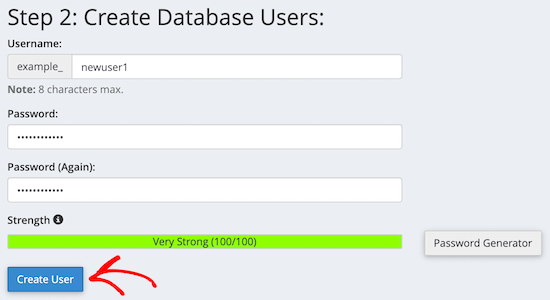
Successivamente, è necessario aggiungere l’utente appena creato al database.
Innanzitutto, selezionare la casella di controllo “Tutti i privilegi”.
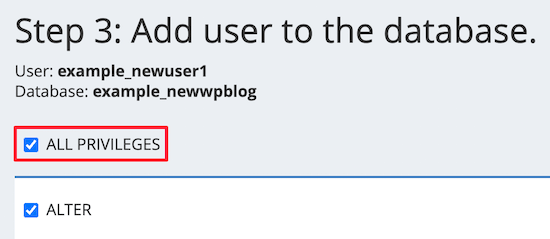
Quindi, scorrere verso il basso e fare clic su “Applica modifiche” per salvare le modifiche.
Avete creato con successo un nuovo database per il vostro sito WordPress live.
Passo 4: Importare il database di WordPress nel sito live
La fase successiva del processo consiste nell’importare il database di WordPress.
Andate nella vostra Bacheca cPanel, scorrete giù fino alla sezione “Database” e fate clic su “phpMyAdmin”.
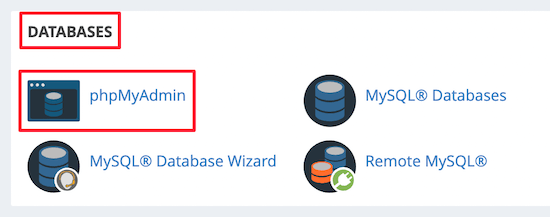
Si accede così a phpMyAdmin, dove si deve fare clic sul database appena creato. phpMyAdmin mostrerà il nuovo database senza tabelle.
Quindi, fare clic sulla scheda “Importa” nel menu superiore. Nella pagina di importazione, fare clic sul pulsante “Scegli file” e selezionare il file del database dal sito locale salvato nel primo passaggio.
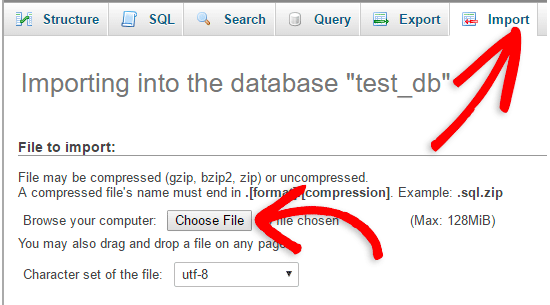
Dopodiché, fare clic sul pulsante “Vai” in fondo alla pagina. Il database verrà importato automaticamente in phpMyadmin.
Passo 5: modificare l’URL del sito
A questo punto, è necessario modificare l’URL del sito nel database in modo che si connetta con il sito WordPress attivo.
In phpMyAdmin, cercate la tabella wp_options nel database che avete appena importato.
Se si è cambiato il prefisso del database, invece di wp_options, potrebbe essere {nuovo_prefisso}_options.
Quindi, fare clic sul pulsante “Sfoglia” accanto a wp_options. Oppure, fate clic sul link nella barra laterale per aprire la pagina con l’elenco dei campi della tabella wp_options.
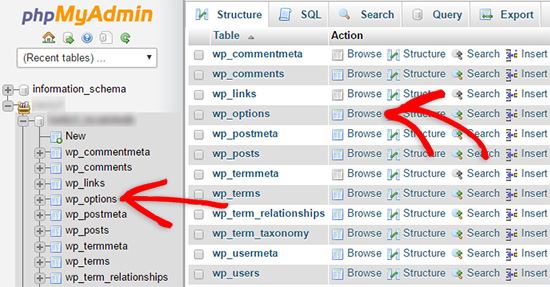
Quindi, nella colonna options_name, occorre cercare l’opzione siteurl.
Quindi, fare clic sull’icona “Modifica”.

Si apre una finestra in cui è possibile modificare il campo.
Nell’input boxed option_value, verrà visualizzato l’URL dell’installazione locale, che sarà qualcosa come http://localhost/test.
In questo campo è necessario inserire l’URL del nuovo sito, ad esempio: https://www.wpbeginner.com.
Quindi, è possibile salvare il campo facendo clic sul pulsante “Vai”.
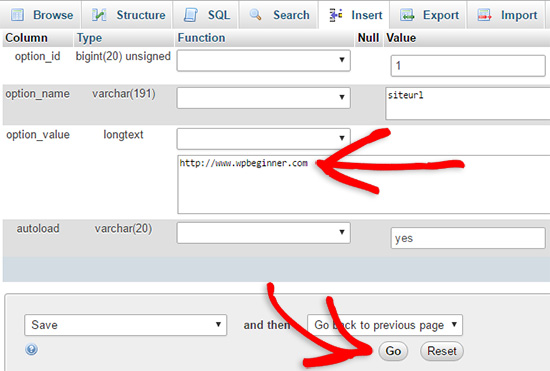
Successivamente, è necessario seguire la stessa procedura descritta sopra per il nome dell’opzione home. Il menu wp_options può essere lungo alcune pagine. Di solito, l’opzione home si trova nella seconda pagina.
Quindi, aggiornare l’URL della home, in modo che sia uguale a quello del sito live.
Passo 6: Configurare il sito live
Ora che avete importato il database e caricato i contenuti, è il momento di configurare WordPress.
A questo punto, il sito dovrebbe mostrare l’errore“Errore nello stabilire una connessione al database“.
Per risolvere il problema, collegarsi al sito web con un client FTP e aprire il file wp-config.php.
Dovrete cercare le seguenti righe di codice:
1 2 3 4 5 6 7 8 9 | // ** MySQL settings - You can get this info from your web host ** ///** The name of the database for WordPress */define( 'DB_NAME', 'database_name_here' );/** MySQL database username */define( 'DB_USER', 'username_here' );/** MySQL database password */define( 'DB_PASSWORD', 'password_here' );/** MySQL hostname */define( 'DB_HOST', 'localhost' ); |
È necessario fornire il nome del database, il nome utente e la password creati in precedenza.
Quindi, salvate il file wp-config.php e caricatelo sul vostro server di hosting WordPress.
Ora, quando si visita il sito web, questo dovrebbe essere attivo.
Dopodiché, è necessario accedere al pannello di amministrazione di WordPress e andare in Impostazioni ” Generale”. Quindi, senza modificare nulla, scorrere fino in fondo e fare clic sul pulsante “Salva modifiche”.
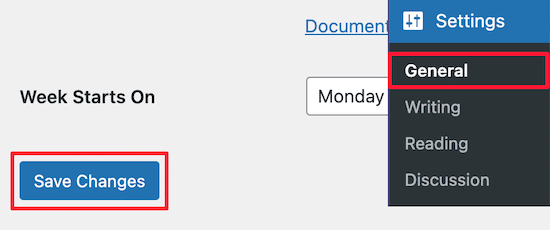
In questo modo ci si assicurerà che l’URL del sito sia corretto ovunque sia necessario.
Una volta fatto, andare su Impostazioni ” Permalinks, quindi scorrere verso il basso e fare clic su “Salva modifiche” per assicurarsi che tutti i link ai post funzionino correttamente.

Passo 7: Correggere le immagini e i link rotti aggiornando i percorsi
Ogni volta che spostate un sito WordPress da un dominio a un altro o da un server locale a un sito live, vi troverete di fronte a collegamenti interrotti e immagini mancanti.
Vi mostriamo due modi per aggiornare gli URL. Potete scegliere quello più adatto a voi.
1. Aggiornare gli URL con il plugin Search & Replace Everything (consigliato)
Il modo più sicuro per correggere questo problema è utilizzare Search & Replace Everything. Si tratta di un potente plugin per WordPress che consente di eseguire facilmente operazioni di aggiornamento di massa sul vostro sito web senza scrivere complesse query al database.
Per prima cosa, è necessario installare e attivare il plugin Search & Replace Everything.
Dopo l’attivazione, andare alla pagina Strumenti ” WP Search & Replace.
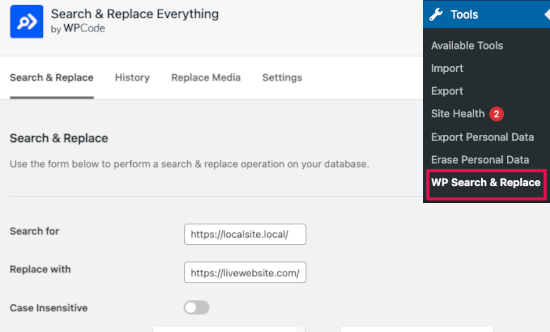
Da qui è necessario inserire l’URL del sito locale nel campo “Cerca” e l’URL del sito live nel campo “Sostituisci con”.
Scorrere un po’ e fare clic su “Seleziona tutto” sotto le tabelle. In questo modo il plugin cercherà il vecchio URL ovunque nel database.

Ora fate clic sul pulsante “Anteprima di ricerca e sostituzione” per continuare.
Il plugin cercherà nel database tutte le istanze del vecchio URL e vedrà l’anteprima dei risultati.
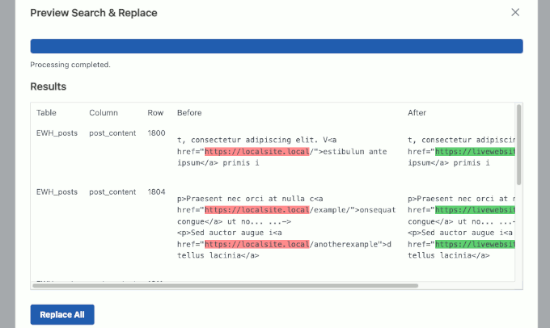
Se tutto sembra a posto, cliccate su “Sostituisci tutto” per salvare le modifiche.
Verrà visualizzata un’attenzione alle modifiche che si stanno apportando. Fare clic su “Sì” per continuare.
Il plugin aggiorna il database e sostituisce gli URL locali con l’URL attuale del sito web.
2. Aggiornare manualmente gli URL (avanzato)
Un altro modo per aggiornare gli URL è utilizzare la seguente query SQL:
1 | UPDATE wp_posts SET post_content = REPLACE(post_content, 'localhost/test/', 'www.yourlivesite.com/'); |
Basta andare su phpMyAdmin, fare clic sul database, quindi cliccare su “SQL” dal menu in alto e aggiungere la query di cui sopra.
Assicurarsi di modificare gli URL del sito locale e del sito live e fare clic sul pulsante “Vai”.
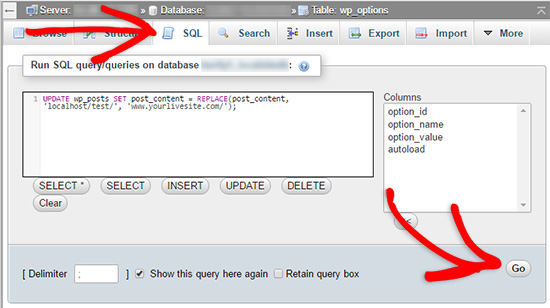
Ecco fatto. Ora avete migrato con successo WordPress dal vostro server locale a un sito live.
Speriamo che il vostro sito web sia attivo e funzionante senza problemi. Se notate degli errori, potete selezionare la nostra guida agli errori comuni di WordPress per aiutarvi nella risoluzione dei problemi.
Speriamo che questo articolo vi abbia aiutato a spostare WordPress da un server locale a un sito live. Potreste anche consultare la nostra guida sullo spostamento di un sito live su un server locale o dare un’occhiata alla lista di controllo definitiva per la migrazione di un sito web per i passaggi pratici della migrazione di WordPress.
Se questo articolo vi è piaciuto, iscrivetevi al nostro canale YouTube per le esercitazioni video su WordPress. Potete trovarci anche su Twitter e Facebook.





Christian
In step 6, wpbeginner support said, need to update these lines in wp-config.php file for an answer of comment (In Nov 2, 2017 at 12:34 am). Here are lines.
define(‘WP_HOME’,’http://example.com’);
define(‘WP_SITEURL’,’http://example.com’);
My question is, After which line should i need to updates these lines in wp-config.php file?
Here is wp-config.php file without comments.
<?php
define('DB_NAME', 'db');
define('DB_USER', 'user');
define('DB_PASSWORD', 'pass');
define('DB_HOST', 'localhost');
define('DB_CHARSET', 'utf8');
define('DB_COLLATE', '');
define('AUTH_KEY', 'put your unique phrase here');
define('SECURE_AUTH_KEY', 'put your unique phrase here');
define('LOGGED_IN_KEY', 'put your unique phrase here');
define('NONCE_KEY', 'put your unique phrase here');
define('AUTH_SALT', 'put your unique phrase here');
define('SECURE_AUTH_SALT', 'put your unique phrase here');
define('LOGGED_IN_SALT', 'put your unique phrase here');
define('NONCE_SALT', 'put your unique phrase here');
$table_prefix = 'wp_';
define('WP_DEBUG', false);
if ( !defined('ABSPATH') )
define('ABSPATH', dirname(__FILE__) . '/');
require_once(ABSPATH . 'wp-settings.php');
WPBeginner Support
Hi Christian,
You can add them any where before the comment line that says:
/* That’s all, stop editing! Happy blogging. */
To be more precise, you can add these lines after:
define('WP_DEBUG', false)1-click Use in WordPress
Admin
Ian Billingham
Hi there.
Would somebody be able to tell me if this ‘how to’ would overwrite an existing established website? I’m guessing it would.
WPBeginner Support
Hi Ian,
Yes, it will overwrite an existing established website.
Admin
Ravishankar
You are awesome!!! Thank you so much, this was super helpful!
Kate
Hi
Thanks for this informative post. I followed all the instructions carefully and when I tried to see if the site was live at step 6, it came up with the same page that it was had originally. It says ‘Index of/’ as the heading and then has 2 options below (with details of date modified etc). The 2 options are cgi-bin which brings up a 403 error and wordpress which goes to a blank page. Any ideas on what I might have done wrong? I’m very new to this so might have got something confused!
Thanks
Ahmed
Thank you very much, this is very useful
Kritika
Nice and helpful. Thanks
Muhammad Azhar
Hi
i am trying to upload my localhost word press site to live.
I am stuck at where it said “error database connection” i edit the wp-config file and now the only white screen appearing on my web site. I am confused what to do next? “Next, you need to login to your WordPress admin panel and go to Settings » General. be.” I have to install word press at my hosting to perform this step. Please guide.
CK Cheung
Hi,
Many thanks for the instruction. I would like to ask is it possible that I just copy the exported database and upload to the FTP site?
Then I can keep the local host for the future upgrade and testing?
If yes, in future which file I should upload to the ftp and make it live??
Many thanks.
kathy
Hi, I wonder if you can help. I’ve got all the way to editing the config file and uploading i would now appear to be at a sticking point – any ideas on the below? Everything has gone fine to this point. I’ve amended the name, user and password as advised. Would really appreciate any pointers. Thanks
i would now appear to be at a sticking point – any ideas on the below? Everything has gone fine to this point. I’ve amended the name, user and password as advised. Would really appreciate any pointers. Thanks
Server Error in ‘/’ Application.
Runtime Error
Description: An application error occurred on the server. The current custom error settings for this application prevent the details of the application error from being viewed remotely (for security reasons). It could, however, be viewed by browsers running on the local server machine.
Amelia
Hi There. I just want to thank you for such an informative site you are running. I feel like you guys literally held my hand the whole way through, and every glitch I had, you had an article about how to fix it.
I’m happy to say my site is now up and running, while I still have to do a few finishing touches though. Just a great big thank you, I could not have done it without following your website step by step.
Nick
I am having issues with step 6, mainly the part where it says “Next, you need to login to your WordPress admin panel and go to Settings » General. Without changing anything, scroll to the bottom and click the Save Changes button. This will ensure that the site URL is corrected anywhere else that it needs to be.
After that go to Settings » Permalink and click Save Changes to ensure that all post links are working fine”. I cannot go into the settings because I cannot login, I have gotten to the login page but it won’t let me login and I cannot create an account because the link is not connected. How would I get around this problem.
WPBeginner Support
Hi Nick,
You can update the URLs in wp-config.php file as well. Connect to your live website using an FTP client and then add these two lines:
define('WP_HOME','http://example.com');define('WP_SITEURL','http://example.com');1-click Use in WordPress
Don’t forget to replace example.com with your own URL.
Admin
Nisa
Thank you very much its was very helpful, I was moving WP files from one server to another.
But I cannot compete the 6th step latter part, I can type the Admin username and password, so the site shows I am logged in as the admin from right hand side corner up, but I cannot access the admin panel
I get the error message : “Sorry, you are not allowed to access this page.”
Judit
Hello,
I took ages to set up my website locally, and now I am ready to move it to a live site. However, when I go to I get an error message:
#1045 – Access denied for user ‘xxx'(my username)@’localhost’ (using password: YES)
I’m pretty sure my username and password are correct and yet I cannot log in or change my password.
Please help – I’m afraid that I invested so much time into setting up WP and now I cannot move it to a live site because of this issue.
WPBeginner Support
Hi Judit,
You will need to edit the phpmyadmin’s configuration file:
c:\wamp\apps\phpmyadmin4.1.14\phpmyadmin.conf
Try root for username and leave password field blank. Set ‘AllowNoPassword’ to true. Save your changes and restart WAMPSERVER
Admin
TH
Hi. I moved my site from my local host wamp to my hosting service.
I did all the steps 1-7 but am facing the following problems:
(I had deleted all my plugins to ensure no conflicts)
– when I login as admin, it shows me the login page instead of the homepage and the admin dashboard.
– header menu bar tabs are working OK except for the HOME tab. When I click on HOME it takes me to localhost. Other tabs take me to the right pages.
– Top bar menu tabs (Favorites, Notifications, Logout) are not working. When I click on Favorites it shows: domainname/login/?redirect_to=http%3A%2F%2domainname%2Fdashboard%2Fprojects%2F#favorites and still shows the login page.
– when I click on logout, it shows domainname/login/domainname/wp-login.php?action=logout&_wpnonce=942fbc8980
– when click on > domainname>dashboard it goes to : domainname/login/?redirect_to=http%3A%2F%2Fdomainname%2Fwp-admin%2F and still shows login page
1. What are the problems with the setup? How do I fix them?
2. Should I delete all the WP files and DB on the live server and try again?
Please help.
Thanks.
TH
WPBeginner Support
Hi,
You may want to follow the steps in our WordPress troubleshooting guide. It will help you figure out what’s causing the issue and how to fix it.
Admin
Tara Giltner
Hi,
I followed these directions, they were great. Thank you. My problem is that I still have an error establishing database. I realize it’s probably because the old website is still on the public_html files as well. Is it ok to delete them?
WPBeginner Support
Hi Tara,
Make sure you download the files as backup on your computer before deleting them.
Admin
Jheel
Kindly revert soon.
Jheel
i followed all the steps mentioned above. the website is blank. and i cant even log in my wordpress website i created offline. after doing all the steps when i try to see if the site is live. i get PAGE NOT FOUND & the page contains the home page without bimage & captions. Please tell me what am i suppose to do?
Klaas Cornelis
I Get the “Forbidden: PHP engine is disable” error after completing this steps, I recon i’ve done something wrong. Anyone has an idea of where the fault can be located?
Jolie King
Hello,
I will like to ask if it possible to upload my wordpress website files by zipping all the folders & files, using the upload button in the cpanel to upload it, and then unzipping it after the upload.
Has anyone tried this? Are there any problems encountered after doing this??
Thanks.
Jim Thorne
Jolie, yes…I Zipped my entire WordPress folder and uploaded it using cPanel and then decompressed it into the public_html folder. It worked fantastic.
alan
wow. i better do it again since this look so difficutl
Amirreza
Very useful. Thanks!
Abneer
Hi,
I successfully moved my website from localhost to live site (with a few exceptions). But i had to work on my localhost also so i used update options method given on Codex . I am able to use my admin panel on localhost and only the frontpage. if i click on any other page on the website i get the wamp configuration page. How can i resolve this issue?
Please help me soon!
Thankyou!
Vince
I could really use anyones help desperately; I spent 2 weeks putting a site together and now I can’t get MAMP to work!!!
I had everything working, built the site then had a power outage. Hadn’t used my computer over the weekend and when I came back had the MySQL Error #2002 in the browser window. None of the other windows had content in them as well.
I’ve tried even going back in my Time Machine and still can’t get it to work. When I start MAMP the Apache Server starts but the MySQL Server doesn’t. I even tried things like restarting Apache and MySQL in Terminal and clearing the cache, but still nothing. And I’ve tried fiddling with the preferences in MAMP.
I’ve used MAMP before, a few years ago without any issues or problems. Loved it!!! Worked Great!!!
I’m using Sierra 10.12.6. I first installed MAMP 4.1.1 then when I started having problems I tried to upgrade to 4.2 to see if that help, but no. Had a few problems at first, but did get it to work.
I have another computer running El Capitan and the MySQL Server just doesn’t start on that either. I thought maybe it was the version of PHP that runs on MacOS, so I ran an upgrade and still nothing!
I’m really despise because the site has a scheduled live date, and the customer will freak if it’s not up and running, not to mention my employer!!! Any help would be greatly appreciated!!!
Cheers, Vince
WPBeginner Support
Hey Vince,
It is a common issue with MAMP and you’ll find various solutions online that have worked for other users. The most common solution is to delete the log files located in MAMP/db/mysql directory and then restarting MAMP.
Admin
Sarah
Hello my web page is still showing blank after enabling WP-DEBUG to true
Chamini
I did every step and now my site is in live.
But now I have another two issues,
1.all of my styles and images were not in the site
2.When I’m trying to go to other menus I can’t go to them.It shows 500 Internal Server Error.
Please help me to get out from here
Chris
Hi, did you fix this? I’m having the same problem.
I’ve deleted .htaccess and created a new one. I’ve changed permalink structure to %postname%, I’ve used the velvet blues AND SQL links update but still get this error. Not sure where else to go from here…
Maiyo
I recommend changing the WP_DEBUG option to true value in the wp_option doc to see what errors are occurring if you have a blank page or HTTP 500 error message
Jordan
I followed the steps exactly, but when I got to step 6 when I loaded the website, it worked, but all the information and templates and pages I designed were not there.
I was still able to access my localhost website and I tried to use WP Migrate to transfer all the information across, but that didn’t work. So I followed this guys instructions:
Now my localhost website does not work anymore…..
I guess I’m just going to have to redesign the entire website online now.
WPBeginner Support
Hi Jordan,
Please review your database settings. Go to phpMyAdmin to compare your live site database with your local server database.
Admin
Nou Kanvanny
Hello sir my appearance dnt see tool option, pleas help me
thank you
Craig
I recieve this error when trying to import my database:
Error
SQL query:
—
— Database: `wordpress_test`
—
CREATE DATABASE IF NOT EXISTS `wordpress_test` DEFAULT CHARACTER SET utf8 COLLATE utf8_general_ci;
MySQL said: Documentation
#1044 – Access denied for user ‘craigpar4_root’@’%’ to database ‘wordpress_test’
Can someone help me?
Thanks
Liv
This seems to have worked, but only on my local computer. The new WordPress website shows up at the proper domain on my computer. But when trying the same domain on my phone or a different computer, the old website still pops up.
Patricia LaCroix
Did you clear the cache on those other computers? Sometimes, that’s the issue.
Susan Keogh
I’m failing at Step 1! I type in the phpmyadmin address – and nothing is found. What am I doing wrong?
MrPET
Dear,
everything you said worked for me. Had some problem with admin back end page but after deleted .htaccess file and refresh, everything is just fine.
Jason
Dear WPBeginner,
I had followed all your steps correctly but now my wp-admin page is gone! it says 404!
Even tho the wp-admin folder exsisted.
Please help
WPBeginner Support
Hi Jason,
Try refreshing your WordPress permalinks structure. Since you can’t access admin area, you will need to do it via FTP. Connect to your website, and locate .htaccess file. Download it to your computer as backup, and then delete the file from your server. Visit the homepage of your website and WordPress will regenerate the .htaccess file for you. You can then try to login.
Admin
Jason
Yeah, you are too late 19 days to respond to my comment…
I had moved my site with pain… that means re-install and copy and pasting stuff from old one to the new one T-T
WPBeginner Support
Hi Jason,
Our apologies for the late reply. We try to respond to comments and questions in a timely manner but due to large number of comments we can sometimes miss legit questions.
Tiernan
Many thanks for the very helpful advice that has really simplified an otherwise tricky process
Kariena
Hi, very useful thanks.
Just a question, when adding content to a plugin on my localhost wp-admin, do I need to import my database again to my live site in order to update changes. (I mean do I need to import my database every time I make changes ?)
Laura
Hello, thanks for the post, it’s super helpful!!! Quick question – should I create my XML sitemap and submit it to Google / Webmaster tools while my site is still on my local server or should I upload it to the live server first?
WPBeginner Support
Hey Laura,
Your would need to upload your site to a live server first.
Admin
jenny
Thank you this is very usefull thank you again
Kim Sofo
I am having problems with this. I think its step 2. Can you please clarify where I should be uploading the wordpress files from? Are they installed as part of WAMP? So thats where I would find them? Or are they elsewhere? Thanks
Rohit Gogoi
Can you make a video on this please…Some steps are not clear. Like the second step. I didn’t got it. Please help me out.
WPBeginner Support
Hey Rohit,
We will try to add a video soon. Meanwhile, you will need an FTP client for the step 2. Once you are connected to your website, you will then upload local WordPress files from your computer to the live website.
Admin
Collins
Thanks a lot, the write up was helpful. However after exporting my database and importing it to my live server, i lost some database files. Is there any possible means or tools to retrieve them back? Help please
Rizki Suciana
Very useful.. thank you so much!
Ari
Thanks for the outstanding post. It really was comprehensive and allowed me to successfully transfer my site from local to server!
The only part I had to be ‘externally resourceful’ on was the save settings when exporting my SQL database, to make sure it didn’t create a new one (as you correctly speculated, my ISP only allowed for one database).
Ritul
Is it safe to transfer website from localhost to live server??because I want to know whether I should start with live hostingOrLocal Server for making my blog??
Kirsty
Please helpppppp
When I changed my url from the .dev to .com it’s telling me 404 site not found and I can’t event get back to wordpress to fix it. :'(
WPBeginner Support
Please see our guide on how to fix 404 error in WordPress.
Admin
Tony Clarkson
Hello, I’m having trouble importing the localhost db content in to the new database, I’ve double checked the step-by-step and as far as I can see I’m doing the right thing but I’m getting this error when importing:
Error
SQL query:
—
— Database: `push_db`
—
— ——————————————————–
—
— Table structure for table `wp_commentmeta`
—
CREATE TABLE `wp_commentmeta` (
`meta_id` BIGINT( 20 ) UNSIGNED NOT NULL ,
`comment_id` BIGINT( 20 ) UNSIGNED NOT NULL DEFAULT ‘0’,
`meta_key` VARCHAR( 255 ) COLLATE utf8mb4_unicode_520_ci DEFAULT NULL ,
`meta_value` LONGTEXT COLLATE utf8mb4_unicode_520_ci
) ENGINE = INNODB DEFAULT CHARSET = utf8mb4 COLLATE = utf8mb4_unicode_520_ci;
MySQL said: Documentation
#1273 – Unknown collation: ‘utf8mb4_unicode_520_ci’
When I choose the custom option for exporting the local database, I’m assuming all the other settings remain as default, just change to ‘Save output to a file’
What do you think it could be?
Tony
Tony Clarkson
I got past this bit, the version of MySQL on the local site was newer then the server, however, I’ve come to a halt again at step 6. When I browse the site I just get an Http Error 500. Not sure where to start…
Peter Singh
Hi Tony,
I had a similar problem with another site that I had to get live a while ago. I found that the root of the http 500 error was due to insufficient memory allowance in the php.ini file. I know you cant really get in and change that about on a webserver. I found a little trick by defining it within the wp-config/php file. Just stick this in at the top line.
define( ‘wp_max_memory_limit’ ‘256m’ )
and bob’s your uncle.
Dawn
I tried this and there was no change… Still either a 500 error or a blank page. :'(
WPBeginner Support
Hey Dawn,
Please try these WordPress troubleshooting steps to figure out what’s causing the issue.
Victor
Hey, Tony. How do you managed the problem with MySQL version? I’m getting the same error here and have no idea where to start. Could you clarify this for me?
Victor
Hello, I managed to bypass this issue, but now I’m with a different one.
All my pages, including WP admin (login, dashboard etc) are showing in plain HTLM. As if there no layout and styling. What could it be?
goutam majumder
Thanks so much for this detail steps. You saved my day.
God bless you
Che Devert
Such a wonderful write up. Thanks.
H Finn
This tutorial is excellent. As long as you follow the steps, and you have no problems on your own end – it works like a charm.
Thank you for this post.
Mohanraj
Hello Friends,
I have done one WordPress project in Local Server. I need to upload wp project in a Sub-Directory. Tell me the Procedures
Stephanie
Hi
I transfered a local website to my live server and followed all steps. I just updated all the URL found with localhost:888 by my final URL
All pages are fine except one where I lost one slider and one table on the page.
Anyone to help me please?
Alex Hammerschmied
I also appreciate this post very much!
It becomes handy everytime i need to walk threw a migration…
Thx for that! And keep on the good work!
Best,
Alex
WPBeginner Support
Hey Alex,
We are glad you find it helpful Don’t forget to join us on Twitter for more WordPress tips and tutorials.
Don’t forget to join us on Twitter for more WordPress tips and tutorials.
Admin